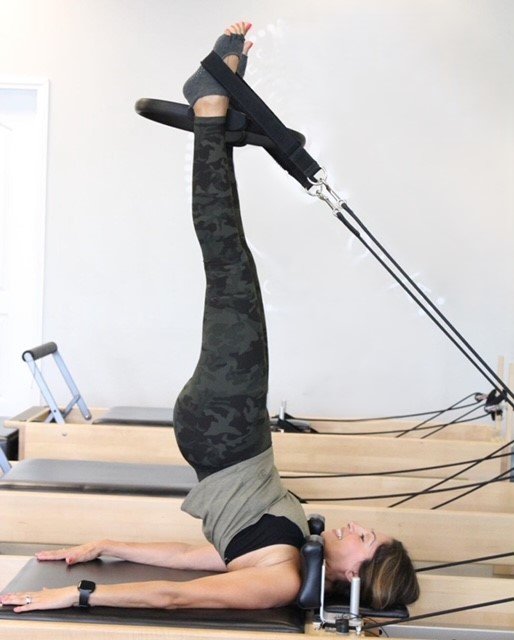
Pilates, pioneered by the late Joseph Pilates, is a mind-body exercise system designed to optimize physical fitness in people at every level of physical ability. Joseph Pilates (1880–1967) was a German expatriate who first made his mark in England during WWI by developing a series of exercises and innovative equipment to help prisoners of war regain strength and mobility. When Joseph Pilates immigrated to New York, the local professional dance community discovered that his conditioning technique, called ‘Contrology’ helped prevent injury and improve strength while maintaining long, even muscle tone.
What are the 5 principles of STOTT PILATES?
The aim of contemporary, anatomically-based Pilates training such as STOTT PILATES, is to develop optimal neuromuscular performance by focusing on core stability, while safely balancing muscular strength with flexibility. Whether performed on a Mat or on specialized equipment, Pilates that incorporates modern theories of exercise science and spinal rehabilitation should include these biomechanical principles
STOTT PILATES Five Basic Principles
Breathing
Pelvic placement
Rib cage placement
Scapular movement and stabilization
Head and cervical placement
By introducing these principles and reinforcing them, awareness of how the body moves is developed. This mind-body awareness ensures focus on precision and control in any Pilates program
Why is Pilates one of the fastest growing methods of exercise?
People are increasingly interested in fitness modalities that help relieve stress and are kinder and gentler to the body, as well as the prevention of injuries with exercise programs that can be continued even as they age. People want to stay fit and functional, and to continue to look good for as long as possible. Pilates is an excellent choice for individuals of all ages and fitness levels who have a variety of fitness goals. Pilates is complementary to many traditional fitness routines and the mind-body connection can be useful in preventing stress related illnesses like heart disease
No form of exercise is appropriate for absolutely everyone, but the STOTT PILATES method is appropriate for most people. As with any training program, always consult with a medical professional before beginning. A modified program created by a well-trained Instructor may be recommended if you have any physical limitations. Everyone from serious fitness enthusiasts to rehab patients, elite athletes, and older clients will see a difference
How does STOTT PILATES differ from traditional weight training?
STOTT PILATES is three-dimensional; meaning exercises are performed in all movement planes
Spring resistance on specially-designed equipment more closely resembles muscular contraction
Emphasis is on concentric and eccentric contraction for injury prevention
STOTT PILATES exercise is customizable for special needs
Emphasis is placed on rebalancing muscles around the joints, correcting over-training and muscle imbalances that lead to injury
STOTT PILATES emphasizes improving strength and flexibility for more efficient movement patterns
STOTT PILATES exercise leads to an improvement in posture and body awareness
Weight training and STOTT PILATES can be combined in a fitness program and are a great complement to each other
Is it true athletes do Pilates?
Despite its slow, careful movements, Pilates is not for wimps! Many pro athletes have discovered the benefit of Pilates exercises, such as NBA stars Kobe Bryant and LeBron James, professional golfer Tiger Woods and entire teams such as the NBA’s Orlando Magic and Washington Wizards, MLB’s Milwaukee Brewers and the NFL’s Detroit Lions, Tampa Bay Buccaneers and Green Bay Packers have all realized the advantage of incorporating STOTT PILATES equipment and instruction in training. STOTT PILATES can help athletes gain a different perspective on how their bodies function and perform.
Should Pilates replace my regular workout?
STOTT PILATES exercise is a musculo-skeletal conditioning program that focuses on strength and stability. STOTT PILATES is ideal in combination with some kind of cardiovascular exercise, such as walking, running, aerobics or aqua fitness, and is a great complement to a weight training program or athletic training. Pilates can and should be done as part of a complete fitness routine
I have a bad back… Will I be able to do Pilates?
Although you should always consult your physician before starting any fitness routine, a Pilates workout is gentle and controlled with a focus on core strength and stability. It is also important, however, that you work with a qualified Instructor to ensure you are doing the exercises correctly and avoiding movements that may not be recommended for your condition.
An experienced Instructor is able to modify the exercises to accommodate your limitations, continually challenge you within your ability, and monitor your improvements. Progress may be slow, but a consistent workout schedule with appropriately chosen exercises with attention and focus will ensure you see results
In some respects, Pilates is like yoga. Both are considered mind-body methods of movement; both emphasize deep breathing and smooth movements that encourage the mind-body connection. The difference is that while yoga requires moving from one static posture to the next, Pilates flows through a series of movements that are more dynamic, systematic and anatomically-based often incorporating resistance equipment. The goal with STOTT PILATES exercise is to strengthen the postural muscles while achieving optimal functional fitness
Can Pilates help me lose weight? If so, how much?
Pilates can be a positive addition to your overall weight-loss program. Weight loss occurs when the number of calories consumed is less than the number of calories expended. The most successful and healthy way to achieve weight loss is an exercise plan that includes an aerobic component coupled with a strength training element, such as STOTT PILATES exercise, and following a balanced diet.
Combining Pilates with cardiovascular exercise also offers additional benefits
Greater mind-body connection
Improved posture
Increased flexibility and mobility


